INTERVIEW WITH THE VAMPIRE (1994)
A vampire tells his epic life story: love, betrayal, loneliness, and hunger.
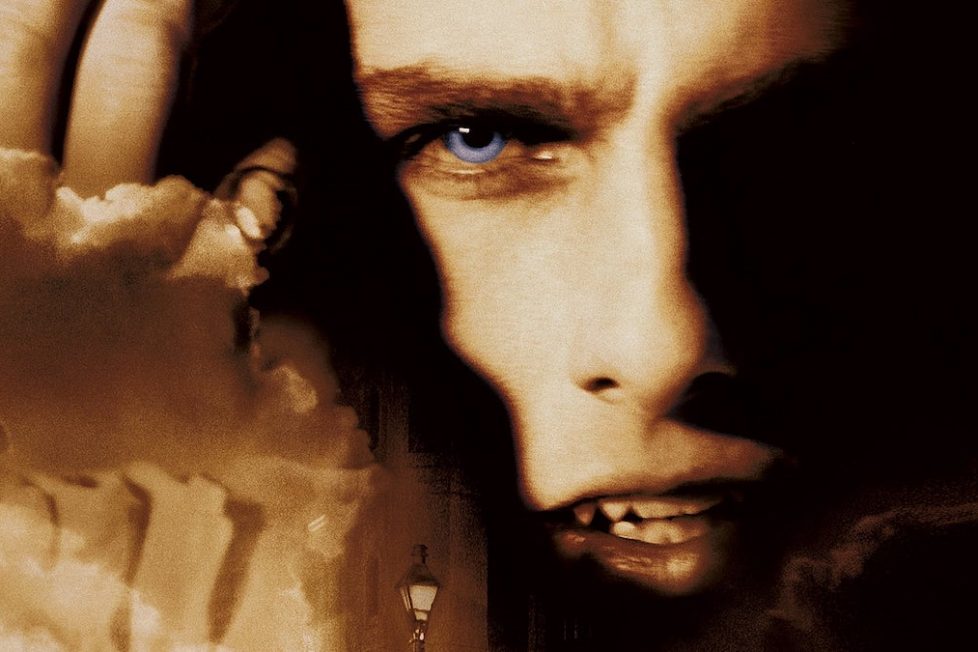
A vampire tells his epic life story: love, betrayal, loneliness, and hunger.


He left me there on the banks of the Mississipi, somewhere between life and death.
Regal. Elegant. Hungry. While chattering aristocrats dance with mechanical precision through lavish golden ballrooms decorated with silks and velvets; while the elegant keys of Wolgang Amadeus Mozart and Joseph Haydn fill the air with their debut melodies; while aged wine is poured freely into the decadent cups of the rich, something more sinister lurks in the shadows.
It’s the late-18th-century, and as paired footsteps dance over the moonlight streaked floor a monster in the corner of the room draws hot crimson from its victim. The latest girl in a long line of girls before her. And as her body writhes in agony, no one seems to notice. She is surrounded by a ballroom of partygoers, of friends, of family, but as the blood is drawn from her helplessly delicate frame, she is alone.
There is romance in her death, a sense of longing. It’s desire. Her lust for life is intermingling with the inevitability of her death—and amongst it all, she is alone.
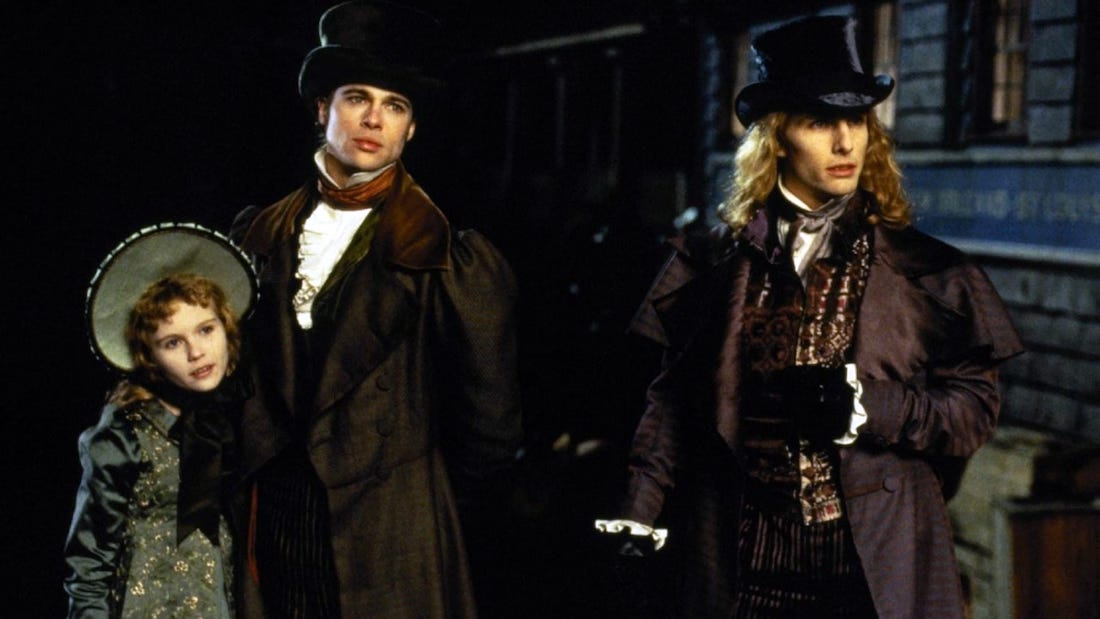
Neil Jordan’s Interview with the Vampire is less a story to be followed and more a picture to behold. It’s something you absorb, consider, and appreciate ike a piece of art hung in the Musée d’Orsay or the Louvre. But as with the world of fine art, it’s so overindulgent in its overflowing grandeur that a less-than-conscientious viewer may find themselves lost between the lines of Anne Rice’s lyrical, poetic dialogue.
But that’s not to the film’s discredit—it’s the essential essence of which this movie is formed. You wouldn’t order chocolate gateaux to fill you up, you order it to let the rich flavours dance across your palate. You focus. You appreciate. You must pay attention if you’re to grasp the true depths of Louis’s (Brad Pitt) solitude, of his lonely journey, but worry not: if you do glance away, even for minutes at a time, you’ll not be lost in the overarching narrative.
It’s a story as simple as simple can be. It’s about a vampire who approaches reporter Daniel Molloy (Christian Slater) for an interview. There’s no particular reason given why this happens. Maybe it’s regret. Or maybe simply to vent. Perhaps, even, it’s an attempt to warn about life as a hunter of the night. Jordan never explores why any further than he needs to, he trusts his viewer to come to their own conclusion. Louis begins the interview talking about his time as a young man, innocent and desperate for a purpose, who is destined to make a terminal error. And because of that, Louis ends up encumbered with an immeasurable, unpayable debt. Life. Eternal. Forever in the darkness.
Despite being set in the era of romantics, there is nothing to be desired in Rice and Jordan’s interpretation of immortality. It’s loneliness incarnate, and the sense of isolation through the film becomes suffocating as you are forced to endure Louis’ century-encompassing life of hunger, lust, and pain.
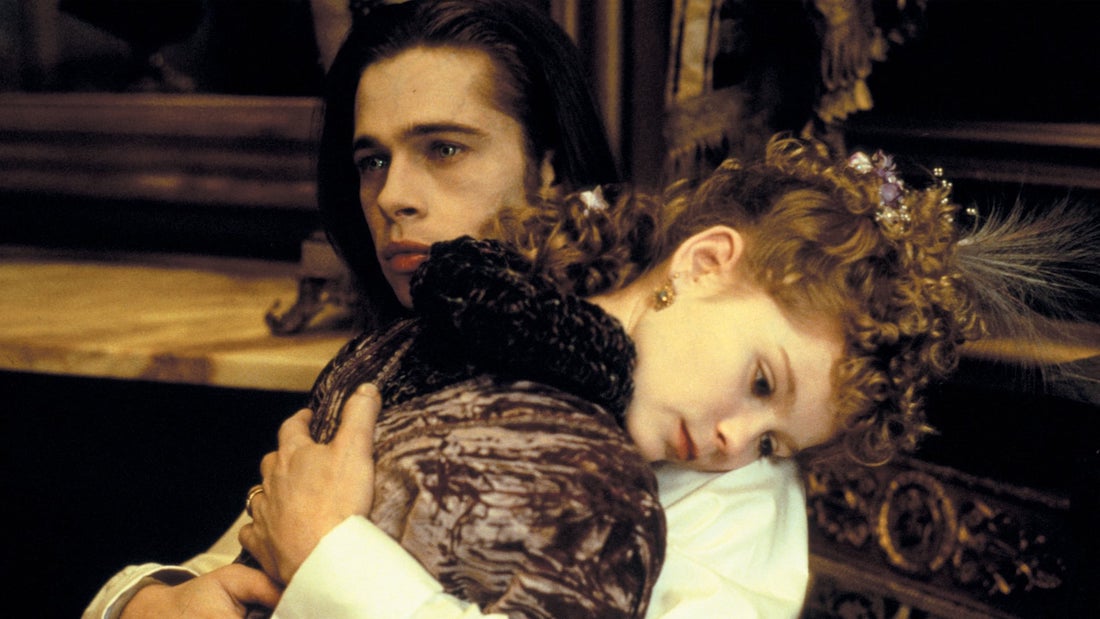
And what a job Brad Pitt does to bring the character to ‘life’. There is a distinct lack of emotion in the star’s eerie gaze, a fearsome monotony in his delivery. He oozes melancholy from the moment he appears on the screen. He looks miserable… because he is.
Brad Pitt spoke to Entertainment Weekly in 2011, and what began as a general, friendly interview spiralled into something else when Interview with the Vampire was brought up. “I am miserable. Six months in the f***ing dark.”
The extraneous makeup process, the contact lenses, the fact he’s “playing the bitch role”—Pitt did all he could to get out of the project during its production. However, his close friend and director, Neil Jordan, made it clear the contract couldn’t be broken without paying a $40M fine—an amount of money that, at the time, was in a different realm of excess for ’90s-era Pitt. Overall, the interaction was calm, relaxed, and devoid of passion. There was no malice, no ill will, it was simply the reality of things. Jordan delivered the information without breaking a beat, and Pitt thanked his friend and moved on in turn. He realised immediately he would have to “man up and ride this through”. And that’s what he did.
So, like his character, Louis, Pitt was stuck with the choice he made. And suddenly, the concept of spontaneous choice brings us to another, more malevolent voice—a voice of one who looks down at Louis and utters the film’s most iconic line:
Don’t be afraid. I’m going to give you the choice I never had.
Lestat.
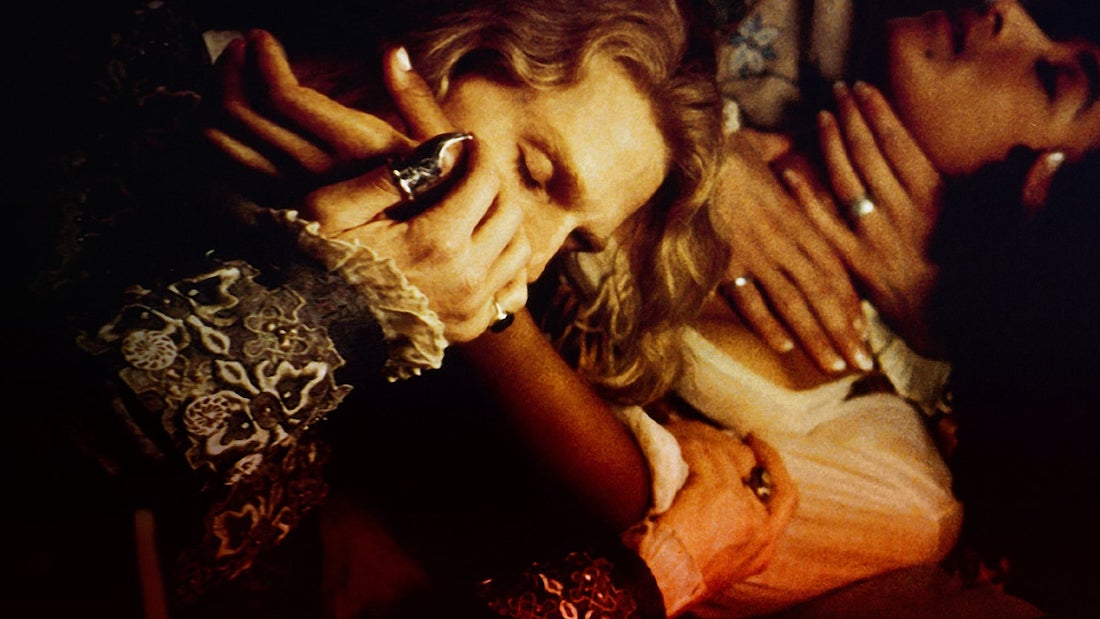
Tom Cruise’s casting as the villainous, enigmatic Lestat was something diehard fans of the book were nervous about. Even Anne Rice, the book’s author and writer of the screenplay, publicly expressed her doubts about producer David Geffen’s casting choice for Lestat. In an interview with Movieline, she described the decision of Tom Cruise becoming the wild, over-the-top vampire as “bizarre” and that his co-star Pitt would’ve been a far better fit for the role. She stated that “he could do Louis, he could do that part, the brooding, dark, guilt-ridden, passive, reflective, reactive thing.” But the idea of Cruise as Lestat left such bitterness on her palate that she began to “despise Hollywood producers and the studio system” and warns “writers… to stay away from them. They will kill you.”
But Anne’s concern, shared by her readers, was immediately alleviated in Lestat’s first on-screen appearance. Cruise’s portrayal of Lestat was nothing less than sensational. He’s the beating heart of the film. He is its energy, its lifeblood. Every scene he is in invokes a pounding sense of whimsical romanticism and primal fear: Tom Cruise is Lestat, and Lestat becomes Cruise.
In Brad Pitt’s 2011 interview with Entertainment Weekly, he admits that the character of Lestat becomes the “pulse of the film” while Louis’ character remains that of a passive observer.
But even with the producer and director’s favouritism of Lestat’s character, Tom Cruise had a monumental task ahead of him. The pressure was on for him to succeed, and thankfully for him (and us), he went above and beyond. Cruise’s preparation for the film involved watching hours of videos of lions attacking and killing zebras to achieve the charming vampire’s subtle (or not so subtle) animalistic tendencies. The headspace he entered was that of an apex predator, with fangs bared and eyes hungry, and that translates perfectly to the silver screen.
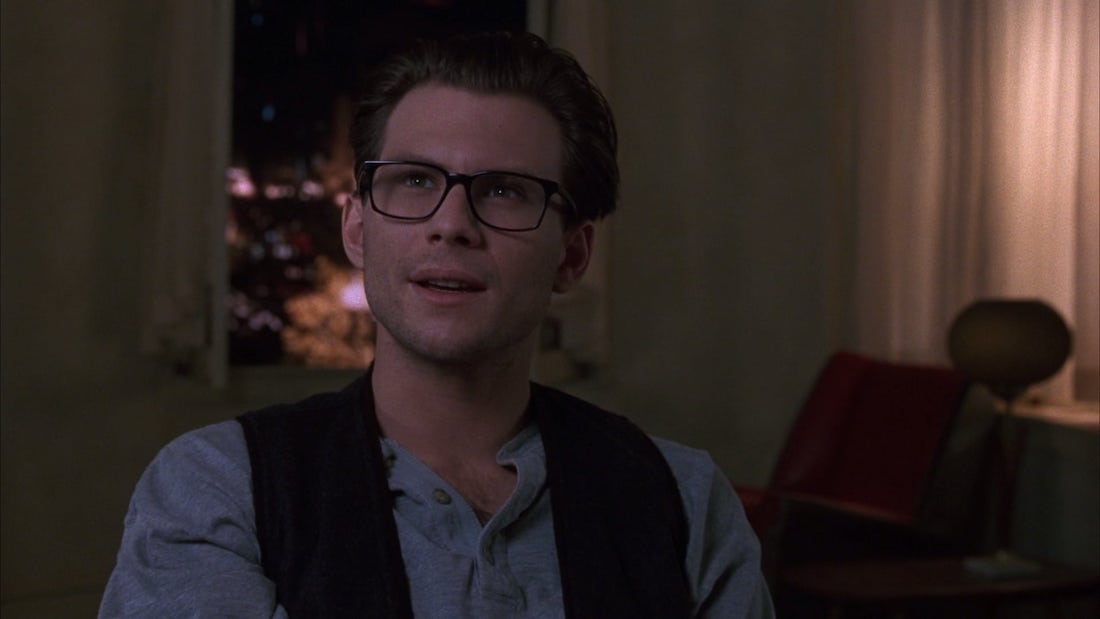
In a Los Angeles Times follow-up interview, Rice apologised for her early criticism of Cruise’s casting. Praising the film in general for going “way beyond her expectations” she pointed out Cruise’s performance, in particular, was “wonderful”.
“I assume I need no introduction,” says Lestat in the film’s final moments, and he’s right.
Interview with the Vampire experienced a turbulent, dubious production cycle. Lingering in development hell for nearly 18 years, Interview with the Vampire’s initial conception was sold to Paramount Pictures, then to Lorimar, and finally, the rights to the film landed nicely in the lap of Warner Bros. Studios. Desperate for the film to soar to heights of her literary vision, Rice requested director Ridley Scott (Alien) to take the lead on the film but he firmly declined. It was then that Warner Bros. approached Neil Jordan for the role of director.
I can only imagine the level of uncertainty that would have gripped Jordan the moment the idea was pitched to him: a Gothic romance centred around vampires—and that’d be a fair and understandable hesitance.
In his interview with Belfast Telegraph, Jordan lamented that “traditionally, [vampire films were] on the lower end of the scale [and in terms of the budget made] on a shoestring, on rudimentary sets”.
In the same period, Shimako Sato’s film Tale of a Vampire (1992) operated on around $1M for production costs, while Shadow of the Vampire (2000) had a budget of just $8M. Even more recently, Dennis Gansel’s German horror flick We Are the Night (2010), found itself confined to a tight budget of around $7.2M.
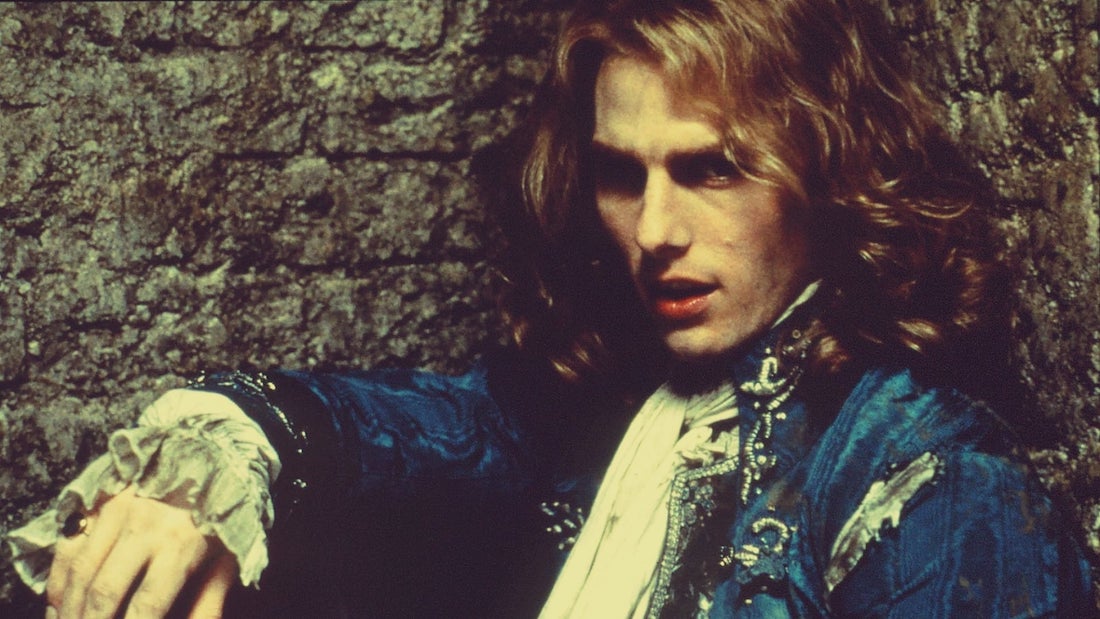
So one can imagine Jordan’s surprise when Warner Bros. offered him a whopping $60M dollars to make Interview with the Vampire—a budget eventually surpassed by a more recent vampire movie, The Twilight Saga–Breaking Dawn: Part 1 (2011). So with an enormous budget secured, the next step for Jordan was to make it good.
Vampires weren’t new territory for the film industry, but historically the genre of monster movies never really took to anything but small bursts of fleeting popularity. They’re loved and then they’re not. Jordan already had his name in the big leagues with his Academy Award-winning film The Crying Game (1992), and Interview with the Vampire was to be the next movie of his career. Despite the financial pressure of producing a successful film for the studio, Jordan’s own pride as a filmmaker was also on the line. It wasn’t about making the movie a hit, it was about making something he was proud to call his own. And Jordan was convinced it could be done the moment he read the script, as he told Una Brankin of the Belfast Telegraph in 2011:
I’d just made The Crying Game; it was a big hit and won an Oscar, you know, and I was sent the Interview with the Vampire script by Warner’s, and thought it was really interesting and slightly theatrical. Then I read the novel, which is extraordinary, so I said I’d do it on the condition that I did my own script, but I didn’t get a credit — it’s very difficult to do so within the Hollywood system. I did try to make it more faithful to the book. I was just anxious to get it made—it was a piece of luck, really. It’s not very often you can make a complicated, dark, dangerous movie and get a big budget for it…. I wanted to make it on an epic scale of something like Gone with the Wind.
So Jordan took Rice’s script and re-wrote it. Initially, as with many aspects of the movie’s pre-production, Rice’s own ego put her at odds with the director’s decision. Upset with the casting of Cruise as Lestat and Jordan’s verdict on rewriting her screenplay, Rice decided to purchase eight pages of advertisement in Hollywood’s leading trade magazine for the sole purpose of openly critiquing the project.
Thankfully, this move never bore fruit. As it was with Anne Rice quickly backpedalling upon seeing Tom Cruise’s onscreen performance, she couldn’t help but acknowledge how impressive the film as a whole truly was. Pulling back by way of a two-page ad in the Daily Variety and the New York Times, Rice wrote a glowing endorsement of the film, calling it a “masterpiece”.
With all the pains and the mighty clashing of egos this film’s pre-production experienced, it’s no wonder that Interview with the Vampire expertly conveys the feeling of despair and suffocating loneliness. Combine the behind-the-scenes drama with an extensive make-up application process (with actors allegedly being hung upside down from the ceiling for thirty minutes at a time) and a six-month filming schedule shot exclusively at night, and you’ve got yourself a cast of despondent, weary actors—perfect for displaying the mournful existence that is eternal life (or death).
Interview with the Vampire carries a distinct emphasis on the idea of beauty. The set design is remarkable, with every scene seemingly cut from a renaissance painting, and there is a sense of mystical regality and nobility found in the dark. With porcelain-like skin, Louis and Lestat are gorgeous figures to behold, practically glowing under the moonlight. There is an ethereal nature to them, and even despite the voracious hunger in their cold gaze, you’re supernaturally drawn to these radiant hunters of the night.
What I find most remarkable, however, is the boldness of the film’s content for the time it was released. There is nudity. There is blood. There is a scene where Lestat picks up a young girl’s, Claudia (Kirsten Dunst), rotted mother’s corpse and begins to dance with it. Oprah Winfrey famously walked out from the premiere screening, saying “I believe there are forces of light and darkness in the world, and I don’t want to be a contributor to the force of darkness”. But by far the film’s most compelling, and progressive, subject matter was that of homoerotica. We’re talking seven years before Netherland signed the world’s fill same-sex marriage legalisation bill, and 21-years before same-sex marriage became a fundamental right in the US. India still doesn’t legally recognise same-sex marriages.
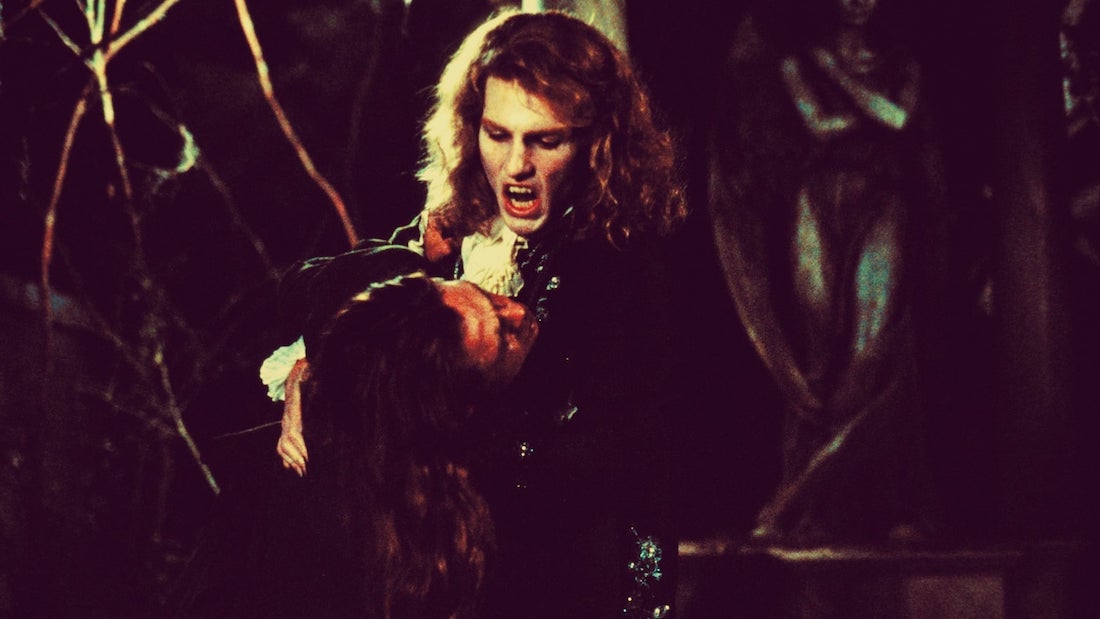
Jordan and Rice’s radical vision of Interview with the Vampire is something to be admired, and something that can be painfully absent from modern films. Interview with the Vampire is a movie that is just as relevant today as it was 25-years ago, if not more so. In a time where we are ruled by technology, dictated by the whims of social media—where we find ourselves uncertain in the world’s current economic climate, the concept of longing is a familiar plague in modern society.
The film delicately balances the romance of eternal life with the harsh realities of becoming something undying. While Louis agonises over his condition as something monstrous (“How do we seem to you? Do you find us beautiful, magical? Our white skin, our fierce eyes? ‘Drink’ you ask me, do you have any idea of the thing you will become?”), Lestat revels in the situation, embracing his dark gift (“Evil is a point of view. God kills indiscriminately and so shall we. For no creatures under God are as we are, none so like him as ourselves.
The heavy, poetic dialogue can be cumbersome at times, especially with the sometimes murmured delivery of the actor’s lines, but there is much meaning to be found for the attentive viewer. The costuming, the make-up, and the set design work together to create an ominous ambience that adds a masterful layer of depth to the film. Nothing is out of place, and the world is shaped with painstaking precision. After watching Interview with the Vampire you’d be forgiven for daydreaming about being whisked away to one of these secret, immortal societies—or you won’t. There’s no right or wrong answer, as Jordan makes it clear that one’s emotions and morals are distinctly separate from another’s.
Though not perfect, this film sits near the summit for all vampire movies and is a must-watch for fans of horror, art, or cinema.

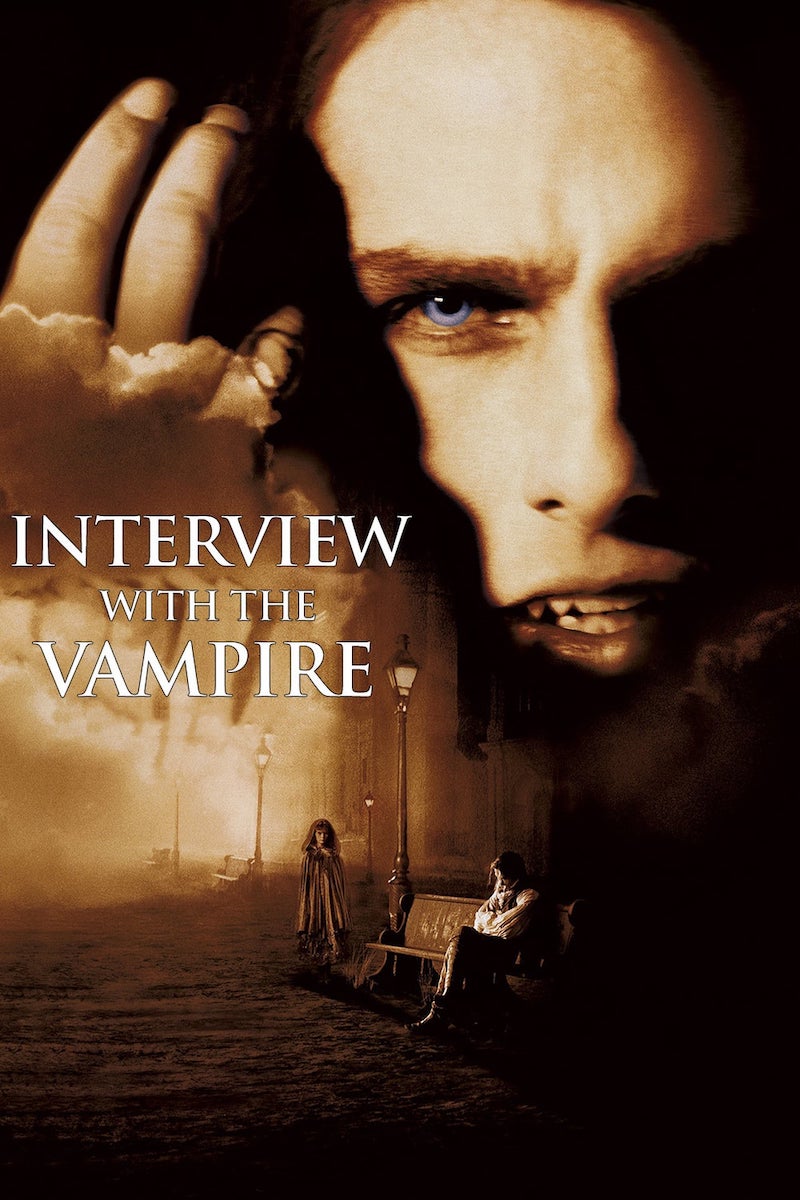
director: Neil Jordan.
writer: Anne Rice (based on her novel).
starring: Tom Cruise, Brad Pitt, Stephen Rea, Antonio Banderas, Christian Slater & Kirsten Dunst.
